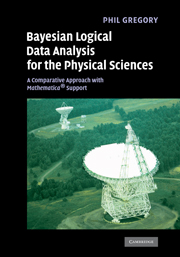 Bayesian Logical Data Analysis for the Physical Sciences
Bayesian Logical Data Analysis for the Physical Sciences Book contents
- Frontmatter
- Contents
- Preface
- Acknowledgements
- 1 Role of probability theory in science
- 2 Probability theory as extended logic
- 3 The how-to of Bayesian inference
- 4 Assigning probabilities
- 5 Frequentist statistical inference
- 6 What is a statistic?
- 7 Frequentist hypothesis testing
- 8 Maximum entropy probabilities
- 9 Bayesian inference with Gaussian errors
- 10 Linear model fitting (Gaussian errors)
- 11 Nonlinear model fitting
- 12 Markov chain Monte Carlo
- 13 Bayesian revolution in spectral analysis
- 14 Bayesian inference with Poisson sampling
- Appendix A Singular value decomposition
- Appendix B Discrete Fourier Transforms
- Appendix C Difference in two samples
- Appendix D Poisson ON/OFF details
- Appendix E Multivariate Gaussian from maximum entropy
- References
- Index
1 - Role of probability theory in science
Published online by Cambridge University Press: 05 September 2012
- Frontmatter
- Contents
- Preface
- Acknowledgements
- 1 Role of probability theory in science
- 2 Probability theory as extended logic
- 3 The how-to of Bayesian inference
- 4 Assigning probabilities
- 5 Frequentist statistical inference
- 6 What is a statistic?
- 7 Frequentist hypothesis testing
- 8 Maximum entropy probabilities
- 9 Bayesian inference with Gaussian errors
- 10 Linear model fitting (Gaussian errors)
- 11 Nonlinear model fitting
- 12 Markov chain Monte Carlo
- 13 Bayesian revolution in spectral analysis
- 14 Bayesian inference with Poisson sampling
- Appendix A Singular value decomposition
- Appendix B Discrete Fourier Transforms
- Appendix C Difference in two samples
- Appendix D Poisson ON/OFF details
- Appendix E Multivariate Gaussian from maximum entropy
- References
- Index
Summary
Scientific inference
This book is primarily concerned with the philosophy and practice of inferring the laws of nature from experimental data and prior information. The role of inference in the larger framework of the scientific method is illustrated in Figure 1.1.
In this simple model, the scientific method is depicted as a loop which is entered through initial observations of nature, followed by the construction of testable hypotheses or theories as to the working of nature, which give rise to the prediction of other properties to be tested by further experimentation or observation. The new data lead to the refinement of our current theories, and/or development of new theories, and the process continues.
The role of deductive inference in this process, especially with regard to deriving the testable predictions of a theory, has long been recognized. Of course, any theory makes certain assumptions about nature which are assumed to be true and these assumptions form the axioms of the deductive inference process. The terms deductive inference and deductive reasoning are considered equivalent in this book. For example, Einstein's Special Theory of Relativity rests on two important assumptions; namely, that the vacuum speed of light is a constant in all inertial reference frames and that the laws of nature have the same form in all inertial frames.
- Type
- Chapter
- Information
- Bayesian Logical Data Analysis for the Physical SciencesA Comparative Approach with Mathematica® Support, pp. 1 - 20Publisher: Cambridge University PressPrint publication year: 2005
